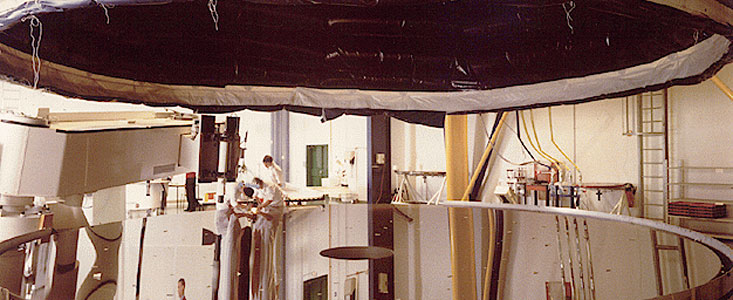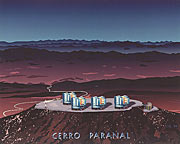Pressemitteilung
First Giant Mirror for the ESO VLT Ready at REOSC
13. November 1995
In 1989, the European Southern Observatory (ESO), the European Organisation for Astronomy, awarded to REOSC, a subsidiary of the SFIM Group and located in Saint Pierre du Perray (France), a comprehensive contract for the polishing of four 8.2-metre diameter mirrors for the unit telescopes of the ESO Very Large Telescope (VLT) project. These mirrors are the largest ever manufactured and polished. This contract comprises not only the polishing and high-precision optical testing of each giant mirror, but also the safe condition of transportation of the blanks which were manufactured by Schott Glaswerke in Mainz (Germany). In order to fulfill the contract, REOSC conceived, built and equipped a novel, high-tech workshop which would allow to polish and test the mirrors, each of which has a surface area of more than 50 square metres.
First 8.2-Metre Mirror is Ready and within Specifications
The REOSC polishing facility for giant mirrors was built in Saint Pierre du Perray, just south of Paris. It is equipped with two machines: one for grinding and the other for polishing the mirrors, and both with 150-actuator systems that support the thin and flexible mirrors. All equipment is computer controlled. State-of-the-art interferometers probe the accuracy of the mirror surface as the polishing proceeds; they are installed at the top level of the facility in a 30-metre high tower, at the centre of the mirror's radius of curvature.
The success of the work at REOSC is now evident by the fact that careful measurements of the first mirror earlier this month have shown that the final optical surface is correct to within 0.00005 millimetres. For illustration, this corresponds to an accuracy of only 1 millimetre deviation over a surface with a diameter of 165 kilometres (equivalent to the entire Paris area)!
ESO Receives the First VLT Mirror
After having been carefully placed in a special transport box designed by REOSC, the first mirror blank, weighing 23.5 tons and with a replacement value of about 20 million DEM, was transported from Mainz to Saint Pierre du Perray in July 1993. The shaping and polishing phases lasted two years and were completed in October 1995. After one month's hard work, dedicated to optical and mechanical verifications by ESO and REOSC, the mirror's various characteristics have now been found to be in accordance with the contract specifications.
Following the technical acceptance, the first mirror was re-installed in its transport container on November 13, 1995. It will thereafter be formally handed over to ESO during a ceremony at REOSC on Tuesday, November 21, 1995.
The mirror will be stored at the REOSC facility until its future departure to ESO's VLT Observatory on Cerro Paranal, a 2650 m high summit in the Andean Cordillera in northern Chile. Here it will be installed in the first VLT unit telescope, soon after the assembly of the mechanical parts has been completed.
Future Plans at REOSC
The polishing of the second VLT mirror, as well as the grinding of the third mirror which was transported from Mainz to Saint Pierre du Perray at the beginning of October 1995, have already started. The transport of the fourth blank will take place in March 1996.
With the construction, in a subsequent phase, of a workshop of more than 6000 square metres and mostly dedicated to space and astronomy, the SFIM group will have invested more than 50 million French Francs at the Saint Pierre du Perray site alone. The group is also involved in the contract related to the actuator support system; this is a clear indication of its determination to maintain its position within this scientific-technological market.
In addition to the ESO VLT mirrors, REOSC will also polish the two 8.2-metre diameter mirrors of the Gemini programme of the Association of Universities for Research in Astronomy (AURA) in the United States. This important work was entrusted REOSC, following an international call for tenders, in which also US firms participated.
Über die Pressemitteilung
| Pressemitteilung Nr.: | eso9530 |
| Legacy ID: | PR 15/95 |
| Name: | Cerro Paranal, Mirror, Paranal, Very Large Telescope |
| Typ: | Unspecified : Technology : Observatory |
| Facility: | Very Large Telescope |
Our use of Cookies
We use cookies that are essential for accessing our websites and using our services. We also use cookies to analyse, measure and improve our websites’ performance, to enable content sharing via social media and to display media content hosted on third-party platforms.
ESO Cookies Policy
The European Organisation for Astronomical Research in the Southern Hemisphere (ESO) is the pre-eminent intergovernmental science and technology organisation in astronomy. It carries out an ambitious programme focused on the design, construction and operation of powerful ground-based observing facilities for astronomy.
This Cookies Policy is intended to provide clarity by outlining the cookies used on the ESO public websites, their functions, the options you have for controlling them, and the ways you can contact us for additional details.
What are cookies?
Cookies are small pieces of data stored on your device by websites you visit. They serve various purposes, such as remembering login credentials and preferences and enhance your browsing experience.
Categories of cookies we use
Essential cookies (always active): These cookies are strictly necessary for the proper functioning of our website. Without these cookies, the website cannot operate correctly, and certain services, such as logging in or accessing secure areas, may not be available; because they are essential for the website’s operation, they cannot be disabled.
Functional Cookies: These cookies enhance your browsing experience by enabling additional features and personalization, such as remembering your preferences and settings. While not strictly necessary for the website to function, they improve usability and convenience; these cookies are only placed if you provide your consent.
Analytics cookies: These cookies collect information about how visitors interact with our website, such as which pages are visited most often and how users navigate the site. This data helps us improve website performance, optimize content, and enhance the user experience; these cookies are only placed if you provide your consent. We use the following analytics cookies.
Matomo Cookies:
This website uses Matomo (formerly Piwik), an open source software which enables the statistical analysis of website visits. Matomo uses cookies (text files) which are saved on your computer and which allow us to analyze how you use our website. The website user information generated by the cookies will only be saved on the servers of our IT Department. We use this information to analyze www.eso.org visits and to prepare reports on website activities. These data will not be disclosed to third parties.
On behalf of ESO, Matomo will use this information for the purpose of evaluating your use of the website, compiling reports on website activity and providing other services relating to website activity and internet usage.
Matomo cookies settings:
Additional Third-party cookies on ESO websites: some of our pages display content from external providers, e.g. YouTube.
Such third-party services are outside of ESO control and may, at any time, change their terms of service, use of cookies, etc.
YouTube: Some videos on the ESO website are embedded from ESO’s official YouTube channel. We have enabled YouTube’s privacy-enhanced mode, meaning that no cookies are set unless the user actively clicks on the video to play it. Additionally, in this mode, YouTube does not store any personally identifiable cookie data for embedded video playbacks. For more details, please refer to YouTube’s embedding videos information page.
Cookies can also be classified based on the following elements.
Regarding the domain, there are:
- First-party cookies, set by the website you are currently visiting. They are stored by the same domain that you are browsing and are used to enhance your experience on that site;
- Third-party cookies, set by a domain other than the one you are currently visiting.
As for their duration, cookies can be:
- Browser-session cookies, which are deleted when the user closes the browser;
- Stored cookies, which stay on the user's device for a predetermined period of time.
How to manage cookies
Cookie settings: You can modify your cookie choices for the ESO webpages at any time by clicking on the link Cookie settings at the bottom of any page.
In your browser: If you wish to delete cookies or instruct your browser to delete or block cookies by default, please visit the help pages of your browser:
Please be aware that if you delete or decline cookies, certain functionalities of our website may be not be available and your browsing experience may be affected.
You can set most browsers to prevent any cookies being placed on your device, but you may then have to manually adjust some preferences every time you visit a site/page. And some services and functionalities may not work properly at all (e.g. profile logging-in, shop check out).
Updates to the ESO Cookies Policy
The ESO Cookies Policy may be subject to future updates, which will be made available on this page.
Additional information
For any queries related to cookies, please contact: pdprATesoDOTorg.
As ESO public webpages are managed by our Department of Communication, your questions will be dealt with the support of the said Department.


